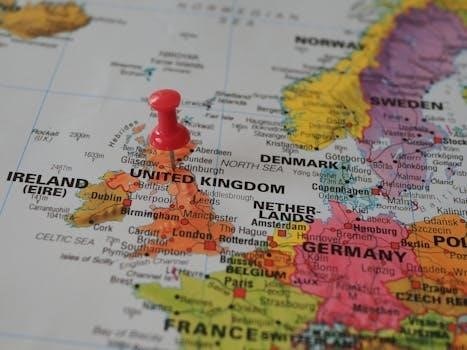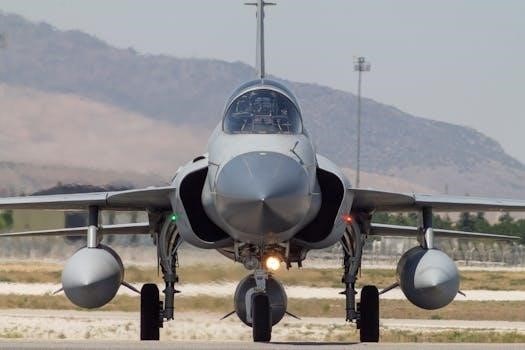
world war 1 study guide the great war
World War I⁚ The Great War ─ Study Guide
This guide offers resources for understanding World War I, also known as the Great War. It covers long-term causes, key events, major players, and the war’s lasting impact, including the Treaty of Versailles. Explore the complexities of this transformative conflict with our comprehensive study materials.
Long-Term Causes of World War I
Several interconnected factors created the environment for World War I. These long-term causes, often remembered by the acronym M.A.I.N., include militarism, alliances, imperialism, and nationalism. Militarism, the aggressive buildup of armed forces, fueled an arms race and heightened tensions across Europe. Alliances, agreements between nations, created a complex web of obligations that drew many countries into the conflict. Imperialism, the competition for colonies, exacerbated rivalries and distrust between European powers. Finally, nationalism, the intense loyalty and pride in one’s nation, fostered an environment where conflict was easily ignited. These underlying causes worked in tandem to create a volatile situation, setting the stage for the outbreak of the war. The assassination of Archduke Franz Ferdinand acted as the spark that ignited the powder keg that had been created by these underlying tensions. These long-term causes were deeply rooted in the European political landscape.
Militarism⁚ The Buildup of Armies
Militarism, a key long-term cause of World War I, involved the aggressive buildup of military forces and the glorification of military power. This created an environment where war was seen as a viable option for resolving disputes. European nations engaged in a competitive arms race, expanding their armies and navies. The focus on military preparedness fueled a culture of fear and suspicion. The belief that a strong military was essential for national security contributed to the escalating tensions. Countries were eager to display their military might, further intensifying the atmosphere of aggression. This arms race was not limited to land forces; naval power also saw significant growth. This widespread militarization created a climate in which a relatively small incident could quickly escalate into a major war. The emphasis on military planning also meant that mobilization plans were in place, ready to be enacted swiftly.
Alliances⁚ Agreements Between Nations
The complex web of alliances formed between European nations was a significant factor leading to World War I. These agreements, intended to provide mutual security, ultimately created a situation where a localized conflict could quickly escalate into a global war. The two main alliances were the Triple Alliance, consisting of Germany, Austria-Hungary, and Italy, and the Triple Entente, comprised of France, Great Britain, and Russia. These alliances created a system of mutual defense obligations, which meant that if one member was attacked, the others were bound to come to its aid. This intricate network of commitments turned a regional dispute into a widespread war. The rigid nature of these alliances left little room for diplomatic resolution. Instead, it created a domino effect where one nation declaring war would trigger a chain reaction, drawing other nations into the conflict. The alliances fostered a sense of obligation and fear, making it difficult to avoid war once tensions rose.

Imperialism⁚ Competition for Colonies
The intense competition for colonies among European powers played a significant role in escalating tensions before World War I. Driven by economic needs for resources and markets, as well as nationalistic ambitions for prestige, nations like Britain, France, and Germany were engaged in a fierce scramble for overseas territories. This expansionist drive led to numerous conflicts and rivalries, particularly in Africa and Asia. The desire to acquire and control colonies fueled mistrust and animosity among European nations. The competition for economic dominance led to a constant state of friction, with each nation vying for the largest and most lucrative colonial holdings. This struggle for global power intensified pre-existing tensions and contributed to the overall atmosphere of hostility. The imperialist race created a sense of zero-sum game where one nation’s gain was seen as another’s loss, further exacerbating the climate of distrust. The focus on colonial expansion diverted attention from domestic issues and fueled a dangerous sense of nationalistic competition. Ultimately, the scramble for colonies served as a key factor in setting the stage for the outbreak of World War I.
Nationalism⁚ Loyalty and Pride in One’s Nation
Nationalism, a fervent sense of loyalty and pride in one’s nation, was a powerful force contributing to the outbreak of World War I. This intense patriotism often manifested as a belief in the superiority of one’s own nation and a desire for national unity and expansion. In many European countries, this led to the suppression of minority groups and fueled rivalries with neighboring states. The concept of national self-determination, which emphasized the right of people with shared identities to form independent states, also played a significant role. This concept both unified some populations and also created conflicts as groups sought independence. In some cases, nationalism took on an aggressive, militaristic tone, promoting the idea that war was a glorious and necessary expression of national strength. This fervent nationalism created an environment where compromise was difficult and where even minor disputes could quickly escalate. The desire to assert national dominance often trumped the need for diplomatic solutions, making conflict more likely. The widespread fervor of nationalism fostered a climate of intense competition and distrust, ultimately contributing to the conditions that made World War I possible.

The Spark⁚ Assassination of Archduke Franz Ferdinand
The assassination of Archduke Franz Ferdinand, heir to the Austro-Hungarian throne, served as the immediate catalyst that ignited World War I. On June 28, 1914, Franz Ferdinand and his wife, Sophie, were murdered in Sarajevo by Gavrilo Princip, a Serbian nationalist associated with the Black Hand, a secret society advocating for the unification of all South Slavs. This act of violence sent shockwaves across Europe, triggering a complex web of alliances and nationalistic tensions that had been simmering for years. Austria-Hungary, with the backing of Germany, saw the assassination as an opportunity to assert its dominance in the Balkans and issued a harsh ultimatum to Serbia, demanding a series of concessions that were designed to be humiliating. Serbia, in turn, was supported by Russia, which had close ties to the Slavic populations in the region. The assassination, though seemingly a localized event, quickly escalated into a full-scale crisis as the network of alliances pulled the major European powers into the conflict. The rigid adherence to these alliances and the unwillingness of leaders to compromise transformed this single act of violence into a global war. The assassination, while not the root cause of the war, provided the spark that ignited the powder keg of European tensions.
Key Players⁚ Central and Allied Powers
World War I saw the major European powers aligned into two opposing factions⁚ the Central Powers and the Allied Powers. The Central Powers primarily consisted of Germany, Austria-Hungary, the Ottoman Empire, and Bulgaria. Germany, with its powerful military and industrial capabilities, was a driving force, while Austria-Hungary, weakened by internal ethnic tensions, sought to maintain control over its vast empire. The Ottoman Empire, already declining, joined the Central Powers seeking to regain lost territories. On the opposing side were the Allied Powers, which included Great Britain, France, Russia, Italy (which joined in 1915), and later the United States (in 1917). Great Britain, with its extensive naval power, played a crucial role in blockading the Central Powers. France, seeking revenge for its defeat in the Franco-Prussian War, was a major force on the Western Front. Russia, despite its internal problems, initially committed large numbers of troops to the Eastern Front. Italy, initially neutral, joined the Allies hoping to gain territory from Austria-Hungary. The United States, initially adopting a policy of neutrality, ultimately joined the Allies in response to German submarine warfare. The clash between these two powerful alliances defined the scope and nature of World War I, with each side bringing its own unique strengths and weaknesses to the conflict.
Major Events and Battles
World War I was marked by several major events and battles that shaped the course of the conflict. The initial German advance through Belgium, known as the Schlieffen Plan, was a crucial early event, leading to the First Battle of the Marne, which halted the German push towards Paris. The battles of Verdun and the Somme on the Western Front were some of the bloodiest of the war, characterized by trench warfare and massive casualties with minimal territorial gains. On the Eastern Front, the Brusilov Offensive was a significant Russian campaign that inflicted heavy losses on Austria-Hungary, while the Battle of Tannenberg resulted in a major Russian defeat. Naval battles like the Battle of Jutland were also important, as they aimed to control the seas. The entry of the United States into the war in 1917 was a turning point, providing fresh troops and resources to the Allied Powers. The Russian Revolution of 1917 led to Russia’s withdrawal from the war, freeing up German troops for the Western Front. The German Spring Offensive in 1918 was a last-ditch effort to win the war, but it ultimately failed. The Allied counteroffensives, including the Hundred Days Offensive, eventually led to the collapse of the Central Powers and the armistice on November 11, 1918, marking the end of the war.
Technological Advancements in Warfare
World War I saw unprecedented technological advancements that dramatically changed the nature of warfare. The introduction of machine guns led to devastating firepower and contributed significantly to the stalemate of trench warfare. Poison gas, including chlorine, mustard gas, and phosgene, was used extensively, causing horrific injuries and psychological trauma. The development of tanks provided a new armored fighting vehicle, though early models were unreliable, they showcased the potential of mechanized warfare. Aircraft also emerged as a crucial part of the war, initially used for reconnaissance but quickly adapted for bombing and aerial combat. Submarines, particularly the German U-boats, became a major threat in naval warfare, disrupting supply lines and engaging in unrestricted submarine warfare. Flamethrowers were deployed in trench warfare to clear out enemy positions, adding another layer of brutality to the fighting. Communications technologies also advanced, with field telephones and wireless telegraphy playing vital roles in coordinating military operations. Improved artillery and explosive technologies made bombardments more destructive. The combination of these technologies made World War I a uniquely deadly conflict, resulting in massive casualties and transforming the face of warfare forever.

The Treaty of Versailles and its Consequences

The Treaty of Versailles, signed in 1919, officially ended World War I but had far-reaching and often detrimental consequences. It imposed harsh penalties on Germany, including significant territorial losses, massive reparations payments, and severe limitations on its military. Germany was forced to accept full responsibility for starting the war, a clause that fueled resentment and humiliation among the German population. The treaty also led to the creation of new nations and redrawing of borders in Europe, which caused further ethnic and political tensions. The economic burden placed on Germany contributed to hyperinflation and economic instability in the following years. These harsh conditions are often cited as a contributing factor to the rise of extremist ideologies, such as Nazism, in Germany. The treaty also failed to address the underlying issues that caused the war, creating an environment ripe for future conflict. The United States, seeking to avoid further entanglement in European affairs, did not ratify the treaty, weakening its international legitimacy. The consequences of the Treaty of Versailles shaped the interwar period and ultimately played a significant role in the outbreak of World War II. Its legacy serves as a cautionary tale about the importance of creating lasting peace.
The Impact of WWI on the World
World War I dramatically reshaped the global landscape, leaving a lasting impact on political, social, and economic systems. The war led to the collapse of four major imperial dynasties⁚ the Habsburgs of Austria-Hungary, the Hohenzollerns of Germany, the Ottoman Empire, and the Romanovs of Russia. This resulted in the creation of new nations and altered the map of Europe significantly. The United States emerged as a world power, playing a crucial role in the war’s outcome and subsequent peace negotiations. The war also accelerated technological advancements in warfare, leading to more deadly and destructive methods. The conflict also had a profound social impact, challenging traditional social structures and roles. Women’s roles expanded as they filled jobs previously held by men, contributing to the push for women’s suffrage. The war resulted in millions of casualties and a generation of traumatized veterans. The economic costs of the war were immense, contributing to global instability and paving the way for the Great Depression. The war’s legacy includes widespread disillusionment and a sense of loss, which significantly influenced literature, art, and philosophy in the post-war period. The war’s effects extended beyond the immediate combatants, impacting colonies and global power dynamics. It ultimately set the stage for future conflicts.
Leave a Reply
You must be logged in to post a comment.